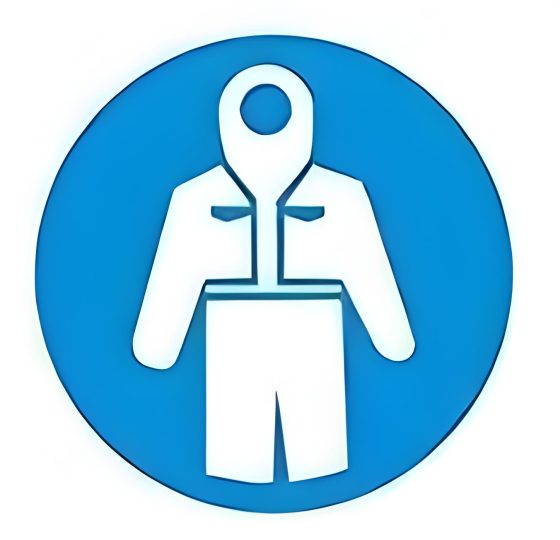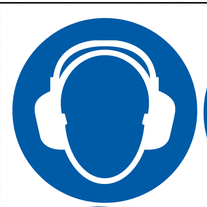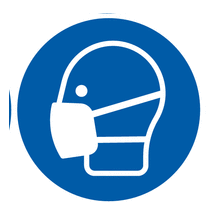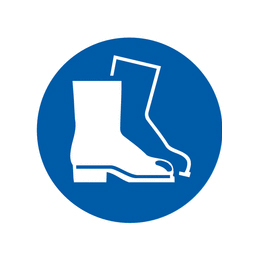ÎN ISO 16321-1:2022
Since 2001, ÎN 166:2001 has been used for CE and UKCA certification of safety eyewear in the European Union and United Kingdom. It is now being replaced by EN ISO 16321-1:2022 – a new set of international standards that will bring some significant changes to product requirements and test methods.
ÎN ISO 16321 was officially published as the replacement for EN 166 in May 2023. The legal adoption date is 11th November 2025 and only products that meet its standards may be tested and certified by official bodies from this date onwards.
However, existing EN 166 certificates which are often used for CE/UKCA markings, will remain valid until their official expiry date up to a maximum of five years. This means, for example, that any products certified or recertified according to EN 166 by 11th November 2025 can be sold legally by manufacturers until 31 October 2029. There is no end date for distributors to have sold their EN certified products by.
Overview of the key changes
ÎN ISO 16321 comprises EN ISO 16321-1:2022, ÎN ISO 16321-2:2021 and EN ISO 16321-3:2022. It introduces numerous changes from EN 166 regarding safety features and testing requirements.
It will involve new certificates and changes in labelling, markings, instructions and packaging for all safety eyewear. The ISO standard includes new safety requirements and new optional features. In some cases, the new standard demands a higher level of protection. In others, the standards become less stringent.
The most significant changes are outlined in greater detail below:
| EN Standard | ISO Standard | Summary |
| ÎN 166 Personal eye protection specifications: ÎN 170 Ultraviolet filters ÎN 171 Infrared filters ÎN 172 Solar radiation filters |
ÎN ISO 16321-1:2022 Eye and face protection for occupational use – Part 1: General requirements ÎN ISO 16321-1:2022 Part 6.3.1 ÎN ISO 16321-1:2022 Part 6.3.2 ÎN ISO 16321-1:2022 Part 6.3.3 |
ÎN ISO 16321 and related parts only applies to plano and prescription glasses for occupational use or use in educational establishments. It excludes face protectors intended for live-working to protect against short-circuit electric arcs, laser protectors, sports eyewear, protectors for use during medical applications, protectors for medically prescribed applications; protectors specifically intended for protection against solar radiation only or protectors intended to protect against ionizing radiation. |
| ÎN 169 Filters for welding and related techniques | ÎN ISO 16321-2:2021 Eye and face protection for occupational use — Part 2: Additional requirements for protectors used during welding and related techniques | The new ÎN ISO 16321-2 standard is broader than ÎN 169 as it applies to complete eye and face protectors used in welding and similar techniques. It includes additional considerations such as frame design and materials suitable for withstanding welding heat and sparks-compatibility with respiratory equipment. |
| ÎN 1731 Mesh type eye and face protectors for industrial and non-industrial use against mechanical hazards and heat | ÎN ISO 16321-3:2022 Eye and face protection for occupational use — Part 3: Additional requirements for mesh protectors | Used alongside ÎN ISO 16321-3:2022, this standard defines the requirements for mesh eye and face protectors which protect against mechanical hazards like flying particles and debris. Notably, a key difference from the older ÎN 1731:2006 standard lies in the mesh design, particularly the aperture count.) |
| ÎN 167 Personal eye protection – optical test methods | ÎN ISO 18526-1:2020 Eye and face protection – Test methods Part 1: Geometrical optical properties | The ÎN 167 standard focuses on optical testing methods for eye protection lenses whereas the ÎN ISO 18526-1:2020 is a broader standard focusing on geometrical optical testing methods for a wider range of eye and face protection. |
| ÎN 170 Ultraviolet filters ÎN 171 Infrared filters ÎN 172 Solar radiation filters |
ÎN ISO 18526-2:2020 Eye and face protection — Test methods — Part 2: Physical optical properties (Filters) | The new ISO 18526-2:2020 standard provides a single source of information for testing all types of filters. It uses more advanced testing methods and promotes consistency across different types of eye and face protection. |
| ÎN 168 Personal eye protection – non-optical test methods | ÎN ISO 18526-3:2020 Eye and face protection — Test methods —Part 3: Physical and mechanical properties | The new ISO standard covers more test methods for both eye and face protection building upon ÎN 168 with a wider range of tests including specific hazards like splashes of molten metals, chemicals, or hot liquids. It also covers the complete eye protector and not just the lens. |
| – | ÎN ISO 18526-4:2020 Eye and face protection — Test methods — Part 4: Headforms | Tests eyewear on six different head and facial sizes intended to replicate 95% of the world’s population. |
COMPARISON OF REQUIREMENTS AND MARKING BETWEEN EN 166 AND ISO 16321 STANDARDS
| PROTECTION
ZONES
|
OPTICAL
TESTS
|
MECHANICAL
TESTS
|
LENS MARKING | FRAME MARKING |
| EN166 : 1 protection zone in the standard
ÎN ISO 16321-1 : 4 protection zones in the standard and 3 dimensiuni (S,M,L)
|
ÎN ISO 16321 – 1 markings:
–1 only (optical clarity) –U for Ultraviolet · R for infraRed · G for solar Glare · W for Welding · K/N for coating tests
|
ÎN ISO 16321 – 1 markings:
· HM for Hight Mass · C, D, E for low, medium, high velocity impact · T for extreme Temperature · K/N for coating tests · 3 for droplets · 4/5 for particles and gases · Protection against liquid projections (6) · Resistance to radiant heat (7) · 9 for Molten metals and hot solids · Chemical resistance (CH)
|
 |
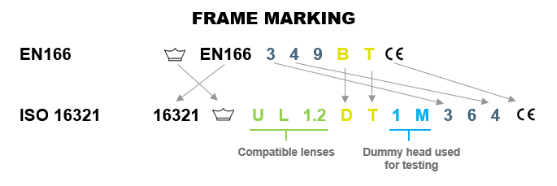 |
 Shanghai Zimai Protection Technology Co., Ltd.
Shanghai Zimai Protection Technology Co., Ltd.

